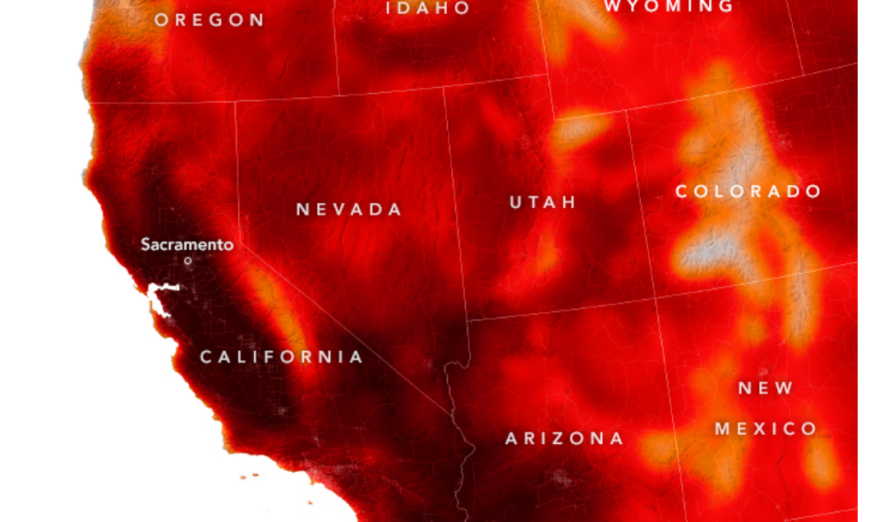September 6, 2022.
In early September 2022, a long-lasting heat dome settled over the U.S. West and brought scorching temperatures that set all-time record highs. The extreme heat fueled wildfires and stressed the power grid before an eastern Pacific tropical storm moved into the region and broke the warm spell.
On September 7, 2022, more than 61 million people were under active extreme heat advisories, watches, and warnings, according to the National Weather Service. Excessive heat warnings were issued for much of California and parts of western Arizona and southern Nevada.
Temperatures reached well into the triple digits (Fahrenheit), with some areas exhibiting record-high nighttime lows and relatively high dew points, both of which contribute to the health effects of heat.
The map above shows air temperatures across the western U.S. on September 6, 2022, at the peak of the heatwave. It was produced by combining satellite observations with temperatures predicted by a version of the Goddard Earth Observing System (GEOS) model, which uses mathematical equations to represent physical processes in the atmosphere.
The map represents temperatures at about 6.5 feet (2 meters) above the ground at about 2 p.m. Pacific Time. The darkest reds indicate temperatures of more than 104°F (40°C). All-time high temperatures ranging into the mid-110s Fahrenheit were recorded in the California cities of Santa Rosa, Napa, Livermore, Redwood City, San Jose, and King City.
Both Merced and Sacramento reached 116°F (46.7°C), their highest temperatures since record-keeping began in 1899 and 1877, respectively. The Sacramento record, which was previously 110°F (43.3°C), was broken by a significant margin. “If you look at the sheer magnitude of all-time high temperatures that were set—in any month, in any year—this heatwave is definitely unique,” said Brian Kahn, an atmospheric scientist at NASA’s Jet Propulsion Laboratory.
But it is also worth noting that this heatwave was not limited to California, he added, as all-time record highs were tied or broken in other western states as well.
Kahn and JPL climate scientist Glynn Hulley recently studied Southern California heatwaves and found that they are becoming more frequent, more intense, and longer-lasting. They are also exhibiting higher nighttime temperatures and humidity, particularly in inland urban areas.
To account for the various factors in a heatwave, the researchers developed a metric called the heat wave severity index. The metric is derived by multiplying the average heat index, which accounts for the effects of temperature and humidity, by the heatwave’s duration. Given the combined intensity and duration of the September 2022 event, Hulley said, it will likely rank as one of the worst heatwaves of the past four decades.
Extreme heat has caused or contributed to the deaths of more than 700 Americans per year on average over the past 30 years. Heat is the leading cause of weather-related death in the U.S., causing more deaths than hurricanes, tornadoes, floods, or extreme cold.

On September 9, cooler temperatures began arriving with Tropical Storm Kay. The storm was expected to bring drenching rains and the potential for flash flooding to Southern California, the Baja Peninsula, and the desert Southwest.
The above image was acquired just after 2 a.m. local time on September 8 by the Visible Infrared Imaging Radiometer Suite (VIIRS) on the Suomi-NPP satellite when Tropical Storm Kay was offshore Baja California. The image uses the VIIRS day-night band, which detects light in a range of wavelengths from green to near-infrared and uses light intensification to enable the detection of dim nighttime signals.
NASA images by Lauren Dauphin and Joshua Stevens, using GEOS-5 data from the Global Modeling and Assimilation Office at NASA GSFC and VIIRS day-night band data from the Suomi National Polar-orbiting Partnership. Story by Sara E. Pratt.
Source, NASA.

